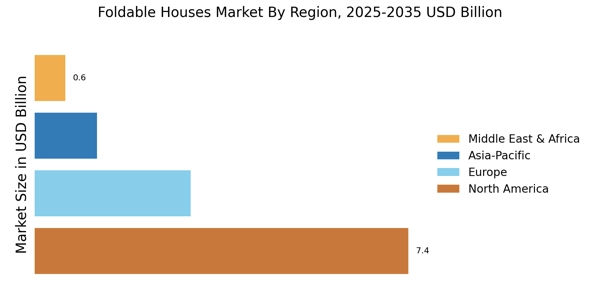Cost Efficiency
The Foldable Houses Market is experiencing a surge in interest due to the cost efficiency associated with foldable housing solutions. These structures often require less material and labor compared to traditional homes, leading to reduced construction costs. In many regions, the average cost of building a conventional house has risen significantly, making foldable houses an attractive alternative. Additionally, the ability to transport and assemble these homes quickly can lead to savings in logistics and time. As housing affordability becomes a pressing issue, particularly in urban areas, the demand for cost-effective housing solutions is likely to increase. This trend suggests that foldable houses may play a crucial role in addressing housing shortages while providing a financially viable option for consumers.
Urbanization Trends
The Foldable Houses Market is significantly influenced by ongoing urbanization trends. As more people migrate to urban areas in search of better opportunities, the demand for housing continues to escalate. Traditional housing solutions often struggle to keep pace with this rapid urban growth, leading to increased pressure on housing markets. Foldable houses present a practical solution to this challenge, offering quick and efficient housing options that can be deployed in urban settings. Their compact design allows for the effective use of limited space, making them suitable for densely populated areas. This adaptability to urban environments suggests that foldable houses could play a pivotal role in addressing the housing crisis in cities, thereby driving their market growth in the coming years.
Technological Advancements
The Foldable Houses Market is benefiting from rapid technological advancements that enhance the functionality and appeal of foldable homes. Innovations in materials science, such as lightweight composites and modular construction techniques, have made it possible to create durable and versatile foldable structures. Additionally, the integration of smart home technologies is becoming increasingly common, allowing for improved energy management and user convenience. As consumers become more tech-savvy, the demand for homes that incorporate modern technology is likely to grow. This trend indicates that foldable houses, equipped with the latest technological features, may attract a broader audience, thereby expanding their market share. The ongoing research and development in this sector suggest a promising future for technologically advanced foldable housing solutions.
Disaster Relief Applications
The Foldable Houses Market is gaining traction due to the increasing recognition of foldable houses as effective solutions for disaster relief. In regions prone to natural disasters, the need for rapid and temporary housing solutions is paramount. Foldable houses can be quickly deployed to provide shelter for displaced individuals, offering a practical and efficient response to emergencies. Their lightweight and portable nature allows for easy transportation to affected areas, where they can be assembled in a short time frame. As governments and humanitarian organizations seek innovative ways to address housing needs in disaster-stricken regions, the demand for foldable houses is likely to rise. This trend highlights the potential of foldable housing solutions to contribute to humanitarian efforts and disaster recovery initiatives.
Environmental Sustainability
The Foldable Houses Market is increasingly aligned with the growing emphasis on environmental sustainability. These homes are often designed with eco-friendly materials and energy-efficient technologies, which appeal to environmentally conscious consumers. The construction of foldable houses typically generates less waste compared to traditional building methods, contributing to a lower carbon footprint. Furthermore, as governments and organizations worldwide implement stricter regulations on building practices, the demand for sustainable housing solutions is expected to rise. This shift towards sustainability not only enhances the appeal of foldable houses but also positions them as a viable solution in the quest for greener living environments. The integration of renewable energy sources in these homes further underscores their potential in promoting sustainable living.


















Leave a Comment